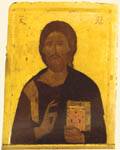|
|
| Portable Icons |
14th c., first two decades Chelandari Monastery Wood, egg tempera, 135 x 100 cm |
|

|
Christ is depicted from the waist up, holding a richly bound, closed Gospel and making a gesture of blessing with his right hand. He wears an aubergine tunic with a clavus and a dark blue himation. The Chelandari Christ represents an iconographical type that was widespread in Byzantine and post-Byzantine art. From an artistic point of view, the iconic type, with its slender proportions, long narrow face, and noble features, has moved away from the robust figure preferred in the second half of the thirteenth century and is reminiscent of the Christ in the Deesis representation in Chora Monastery in Constantinople (1318-21; Underwood 1966, vol. 2, fig. 39). As regards the rendering of the face, although the highlights have flaked off, the icon stands out for the delicacy of the painting and the benevolent expression on Christ's face. Apart from its dimensions, this icon of Christ also shares technical and stylistic similarities with the icon of the Virgin Hodegetria from Chelandari (no. 2.16). They were both despotic icons on the templon in the new katholikon, which the Serbian ruler Stephen Milutin built for the monastery in 1293. On the basis of these shared characteristics, both icons may be dated to the first two decades of the fourteenth century and ascribed to the same workshop, which was from Thessaloniki.
| |
|
Bibliography: Radojcic 1955 (1), p. 173, fig. 23. Bogdanovic - Djuric - Medakovic 1977, p. 86, fig. 70.
| ||
| E.N.T. | ||
| Index of exhibits of Monastery of Chelandari 14th century |
||
Reference address : https://www.elpenor.org/athos/en/e218ab17.asp